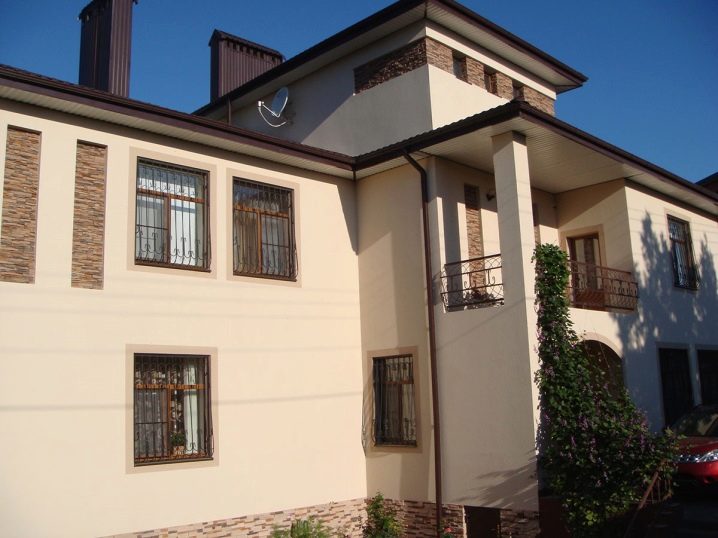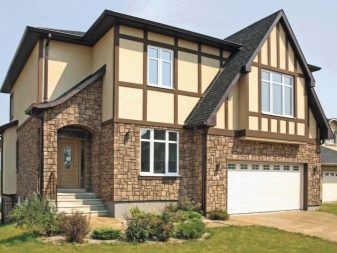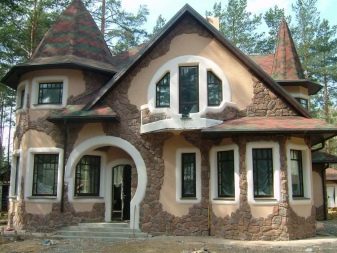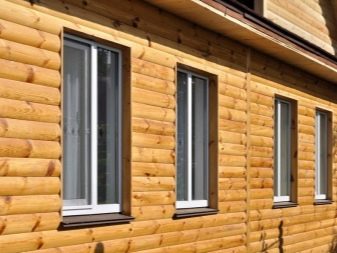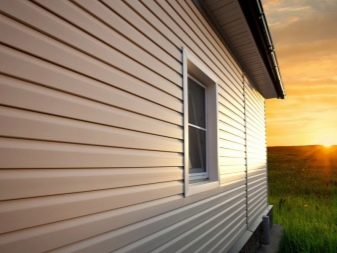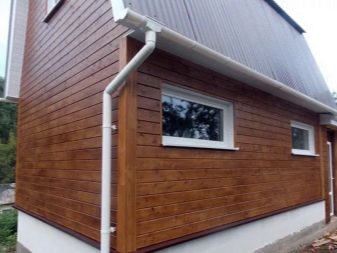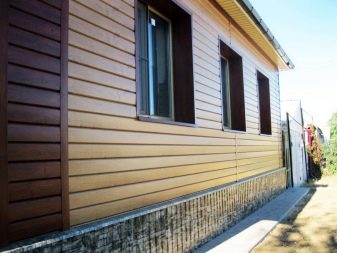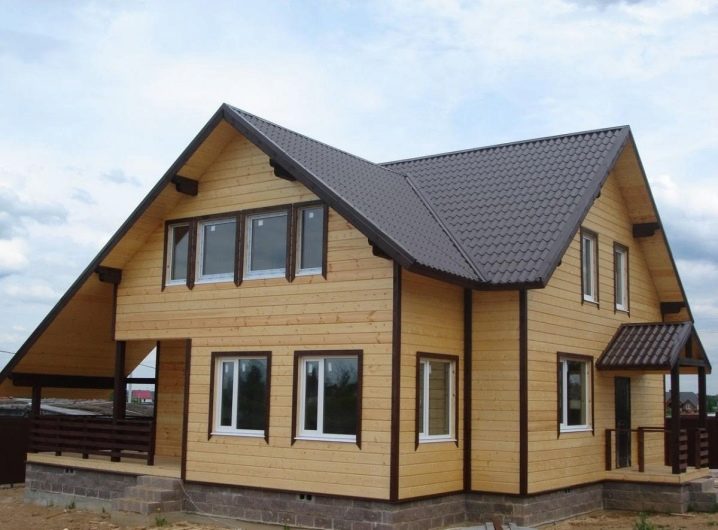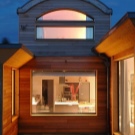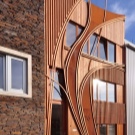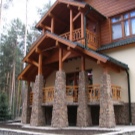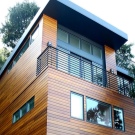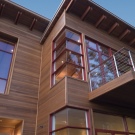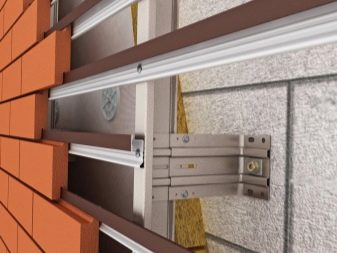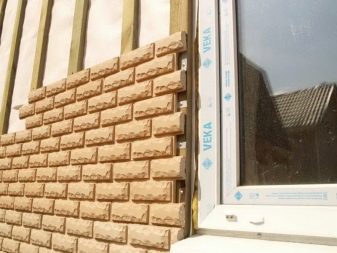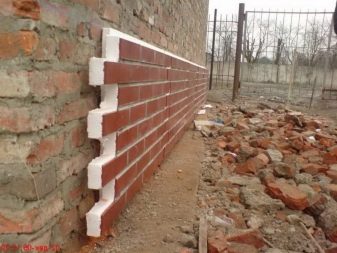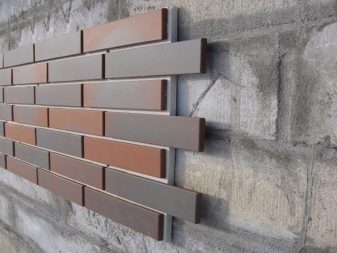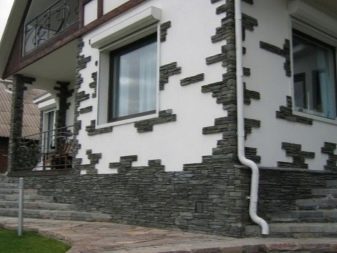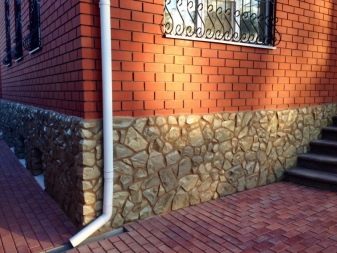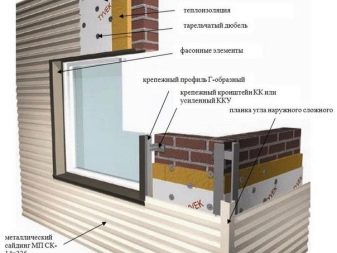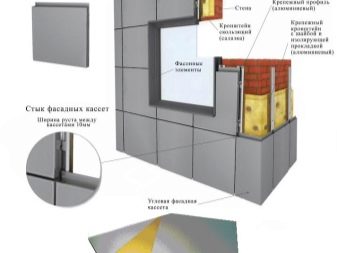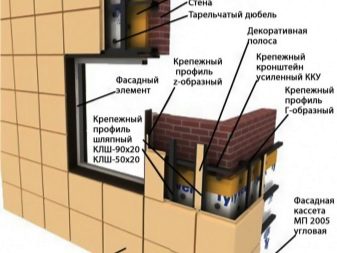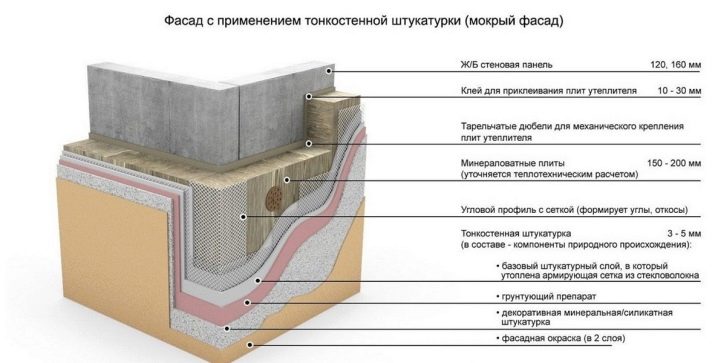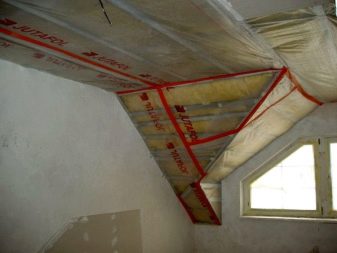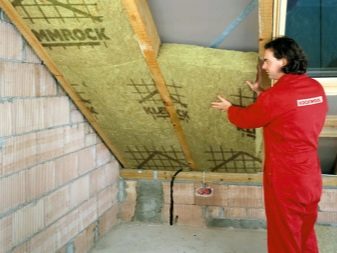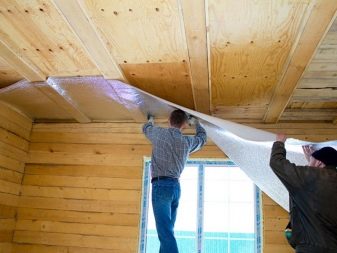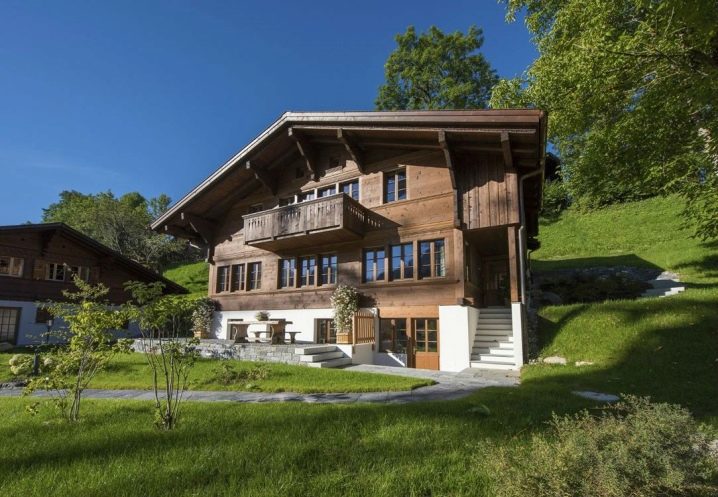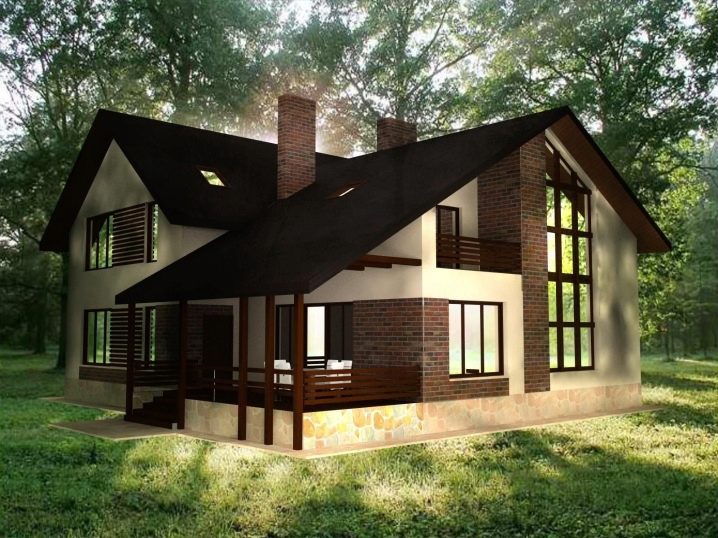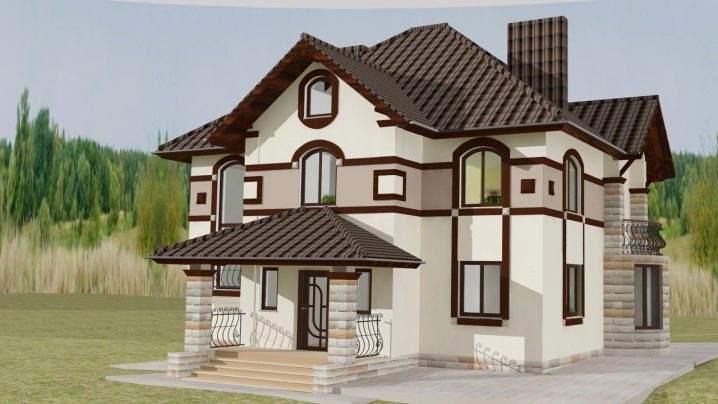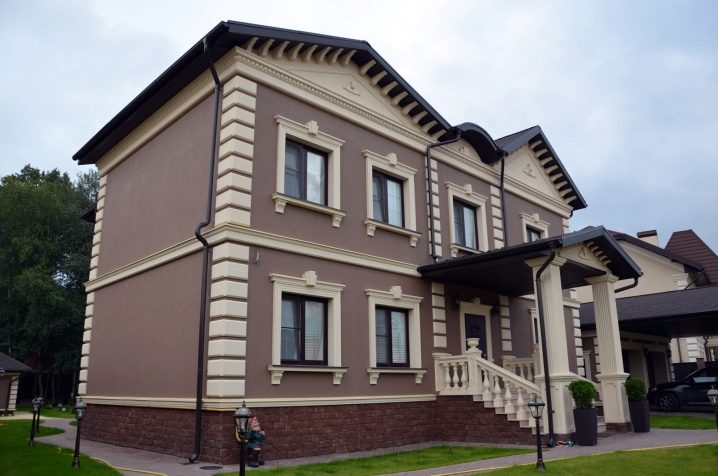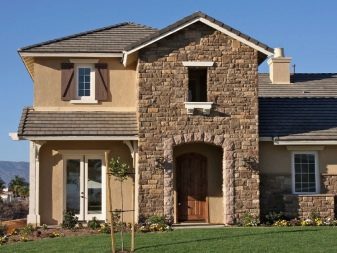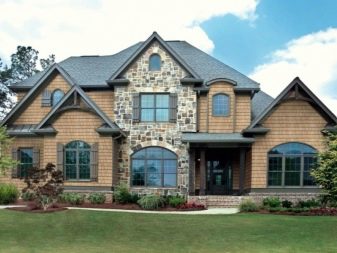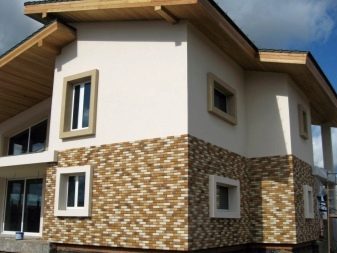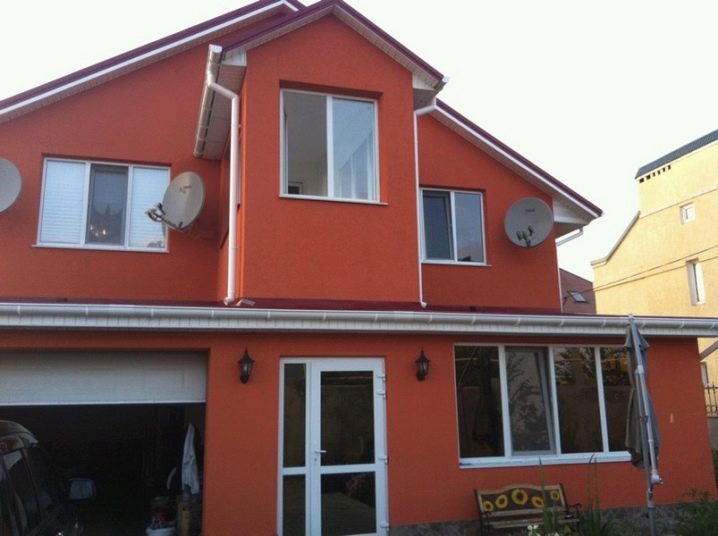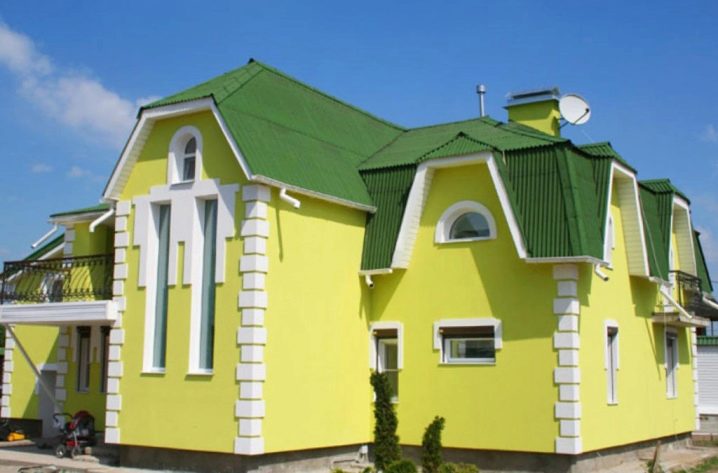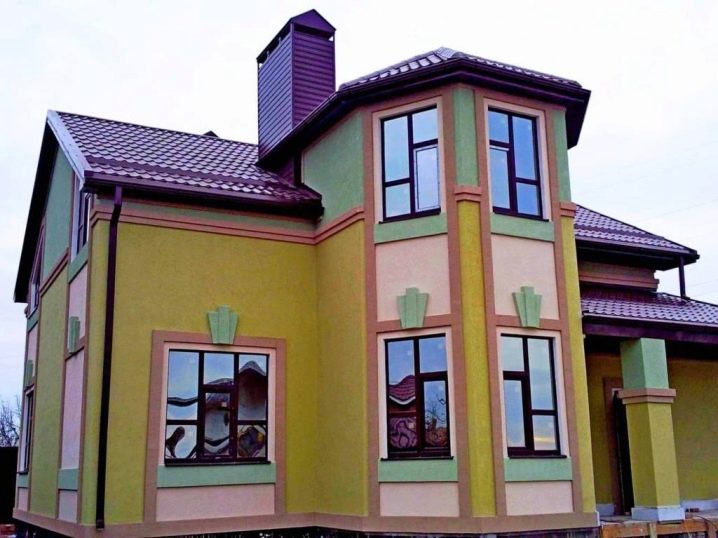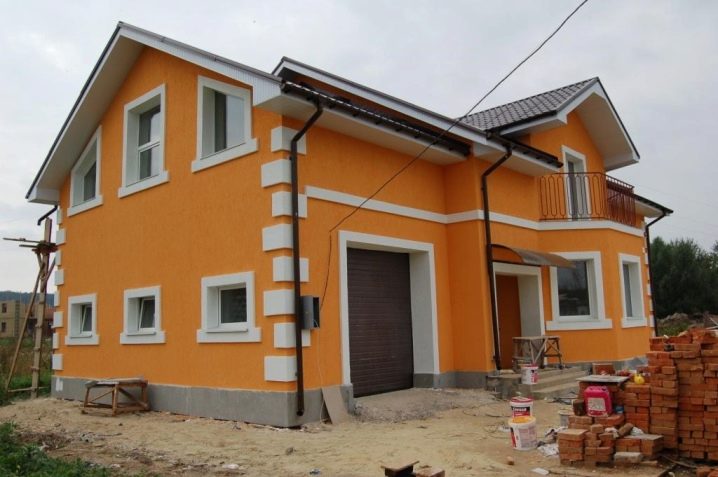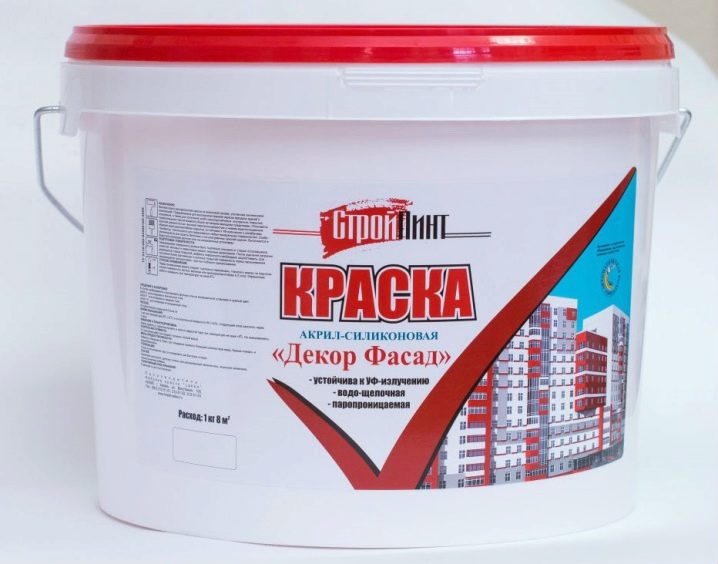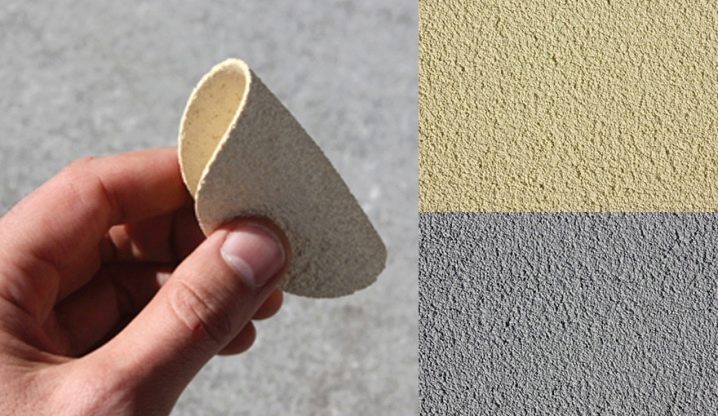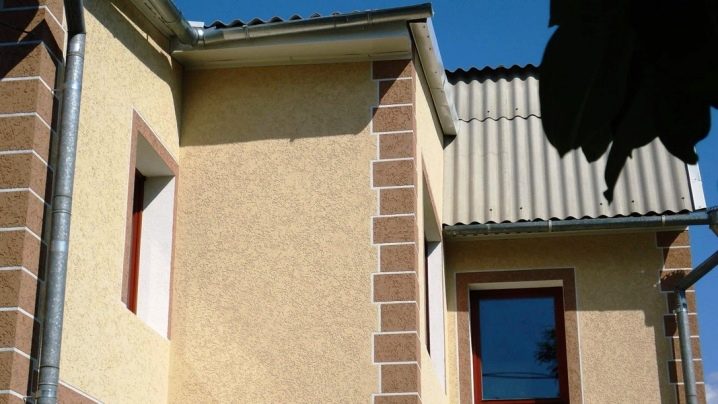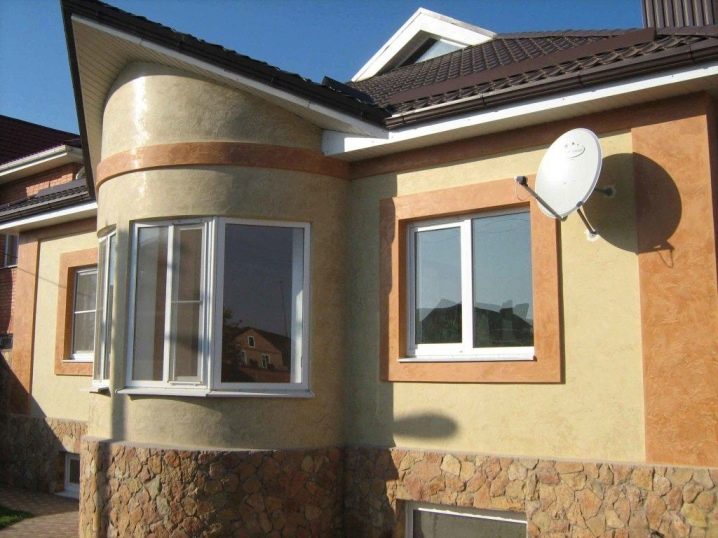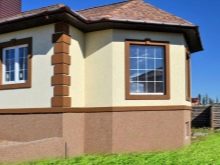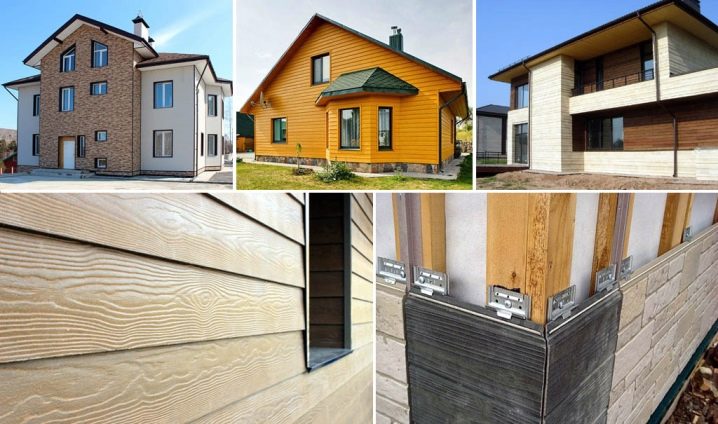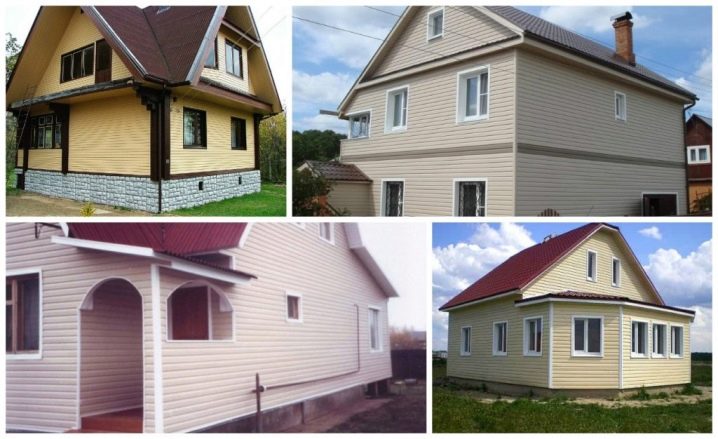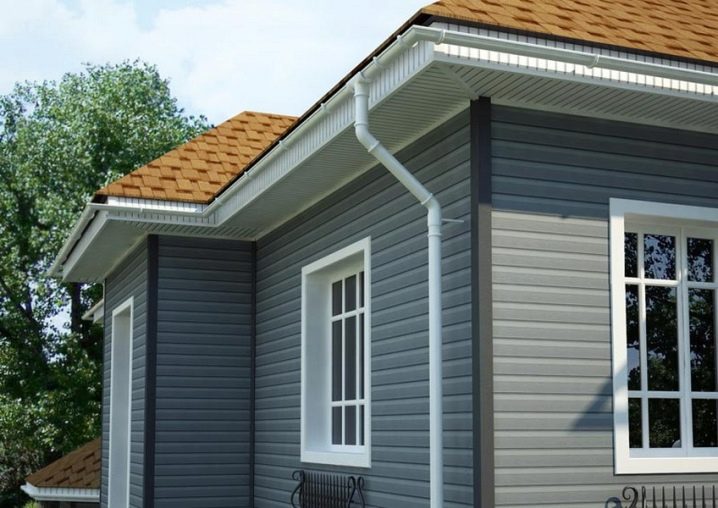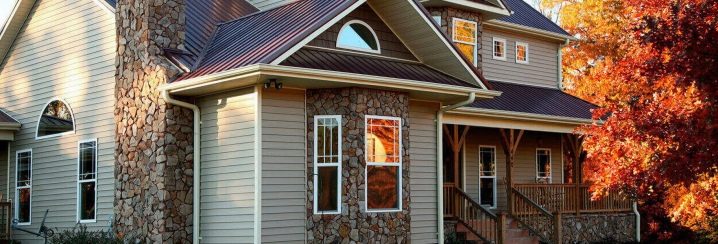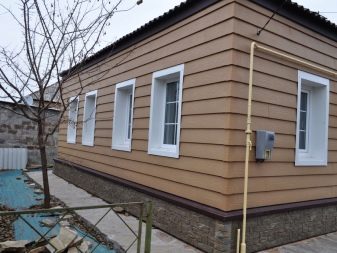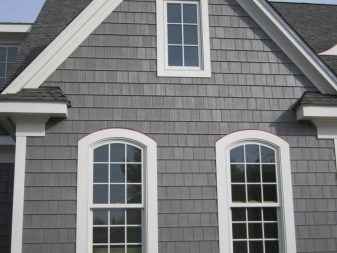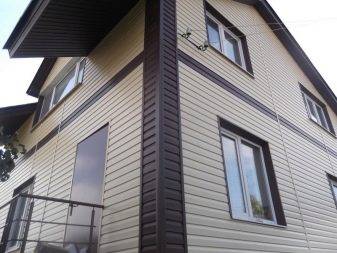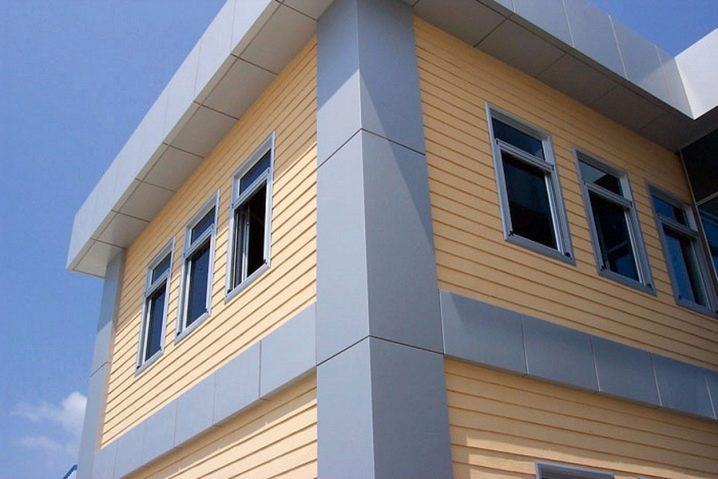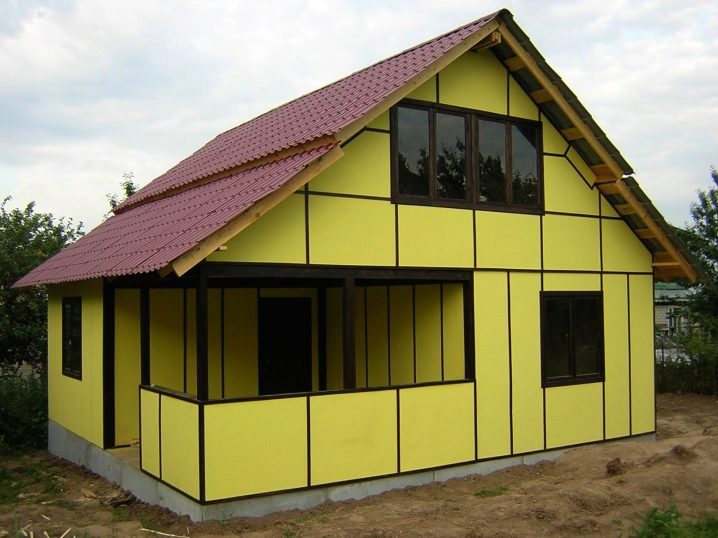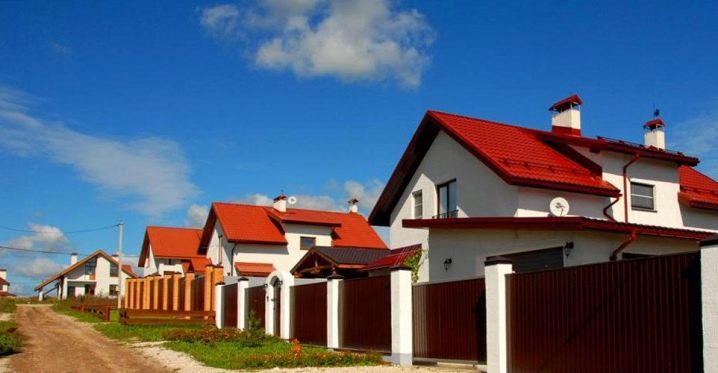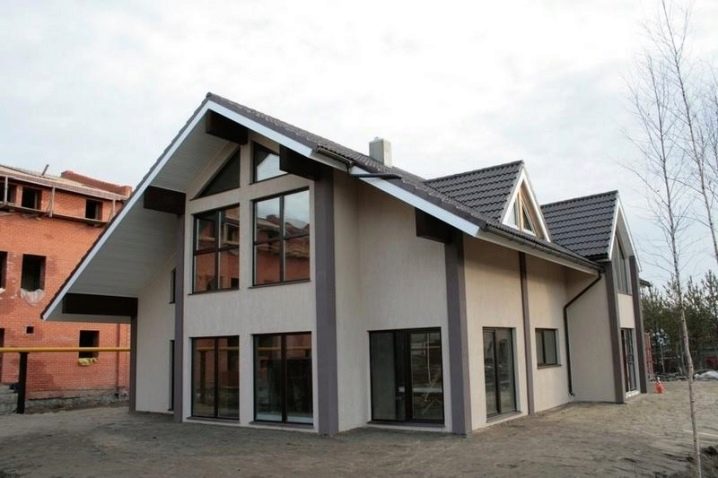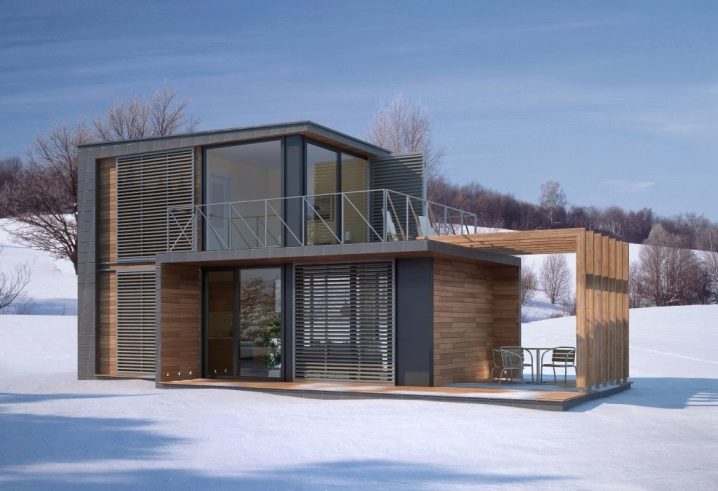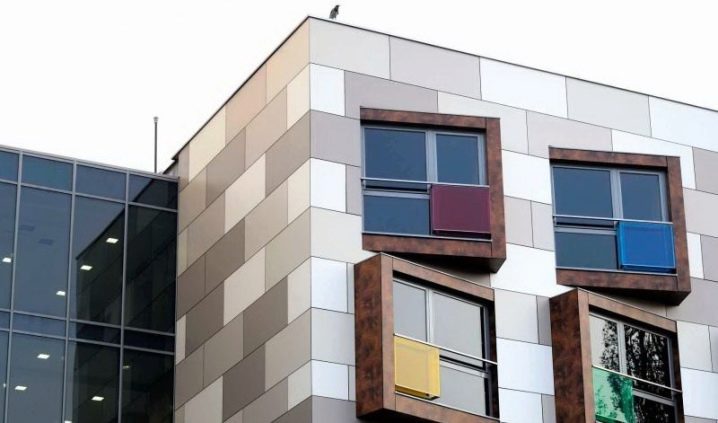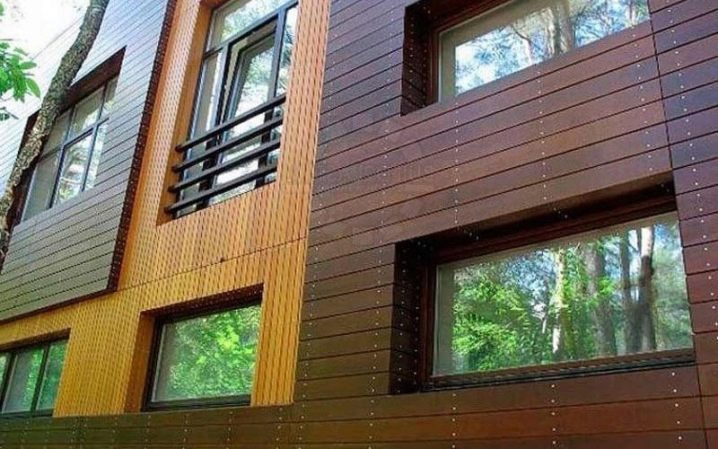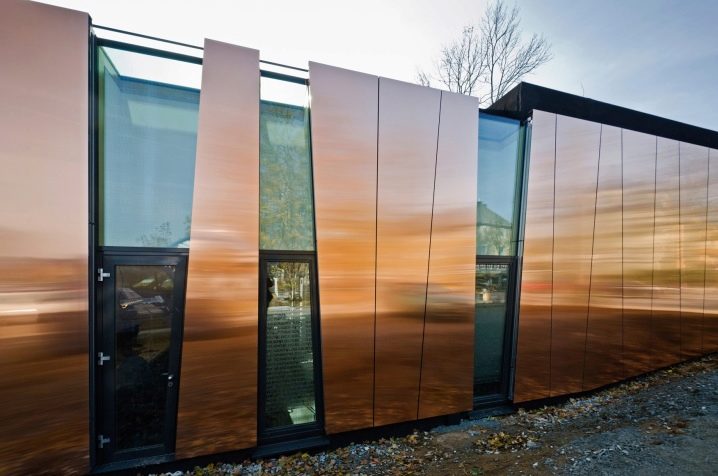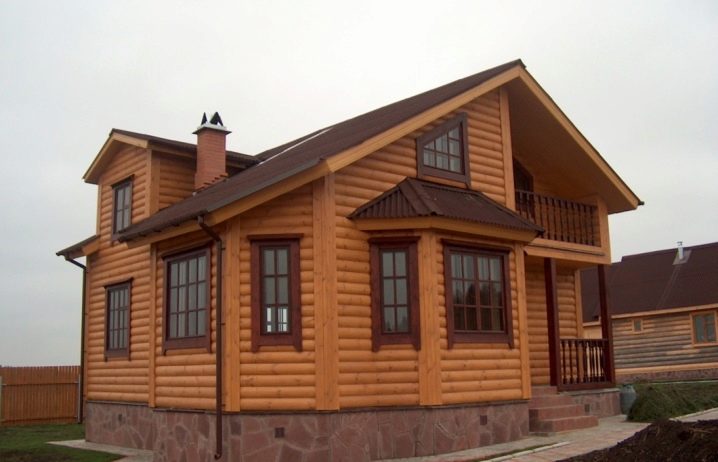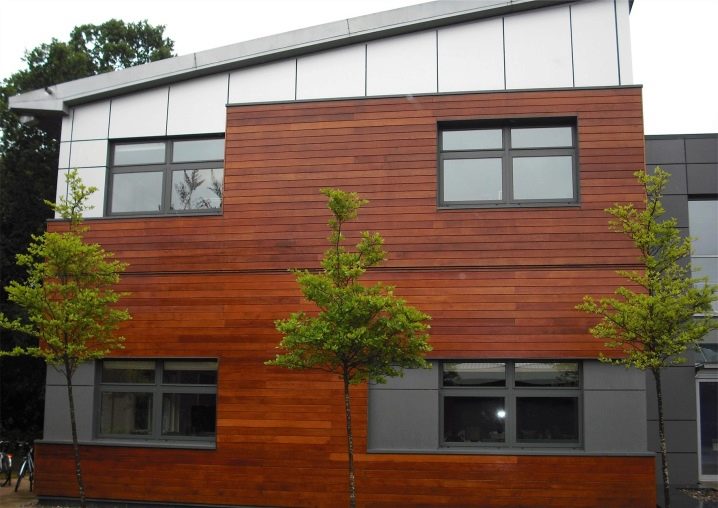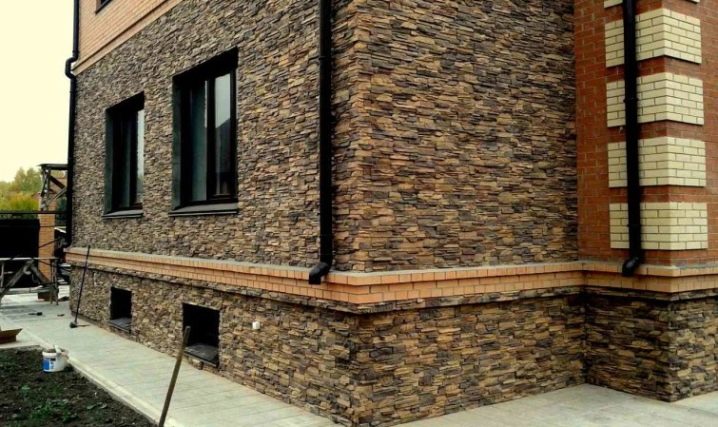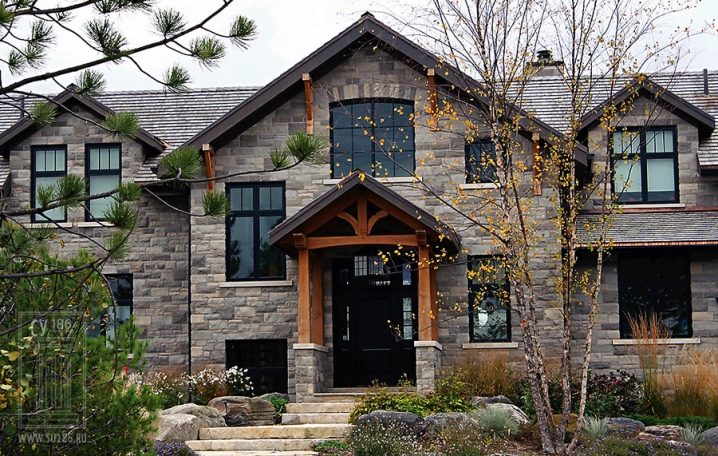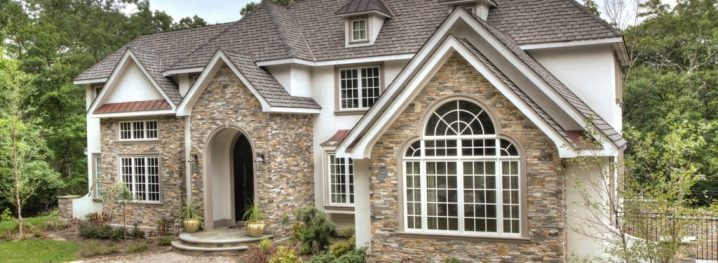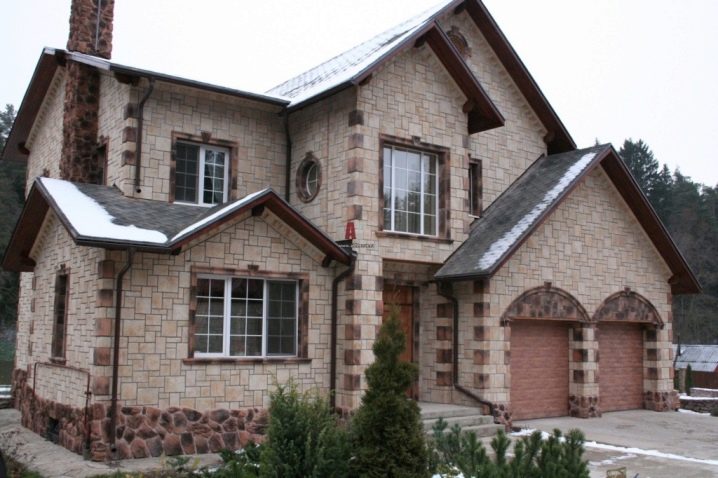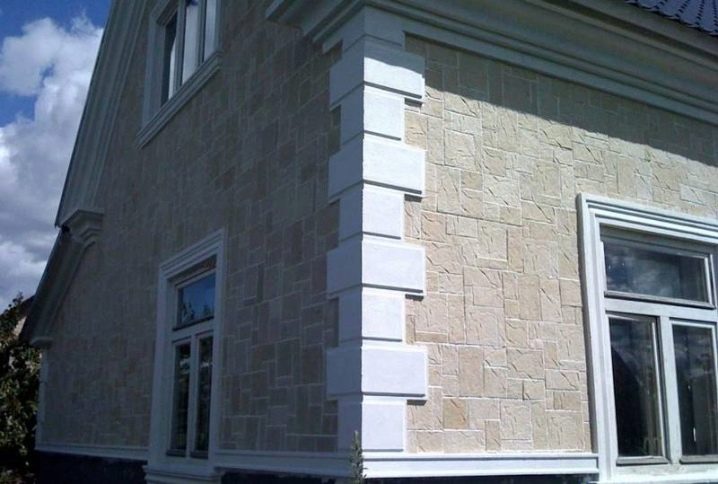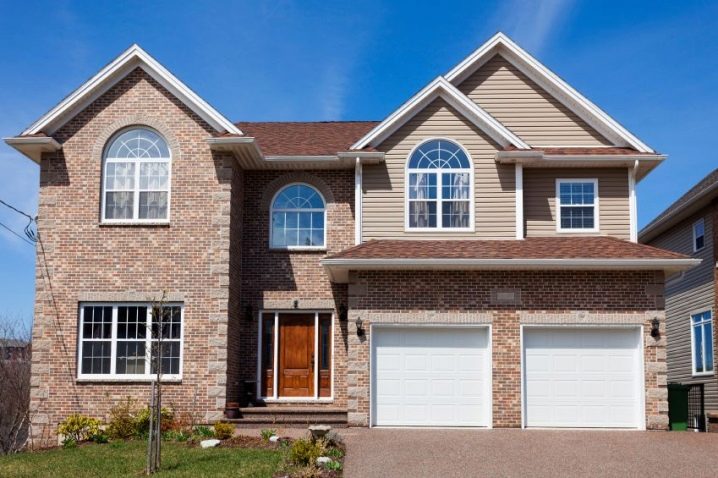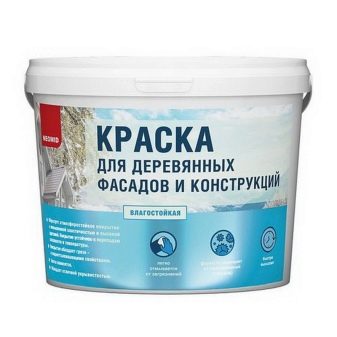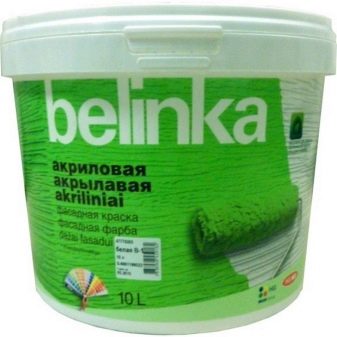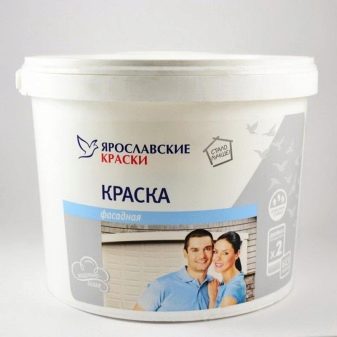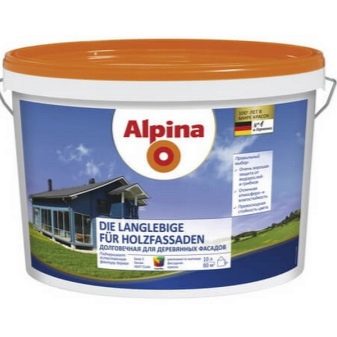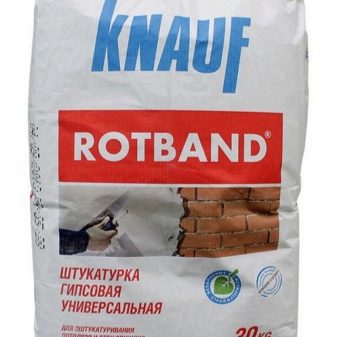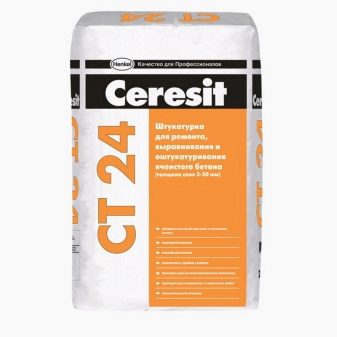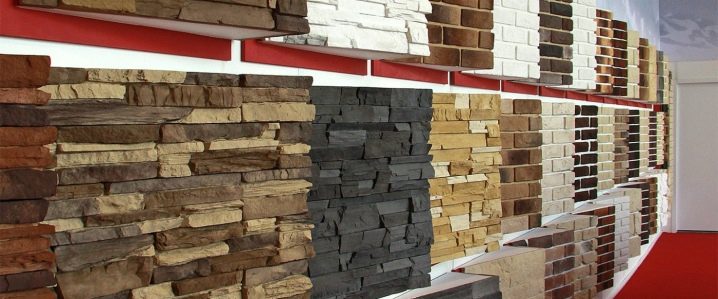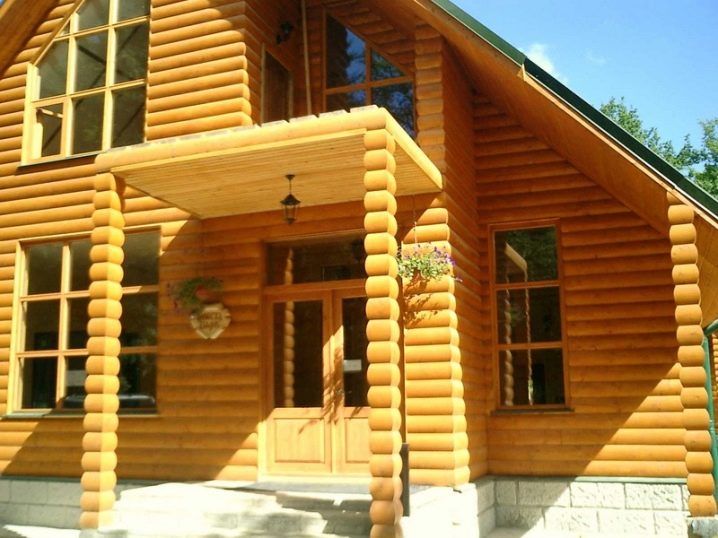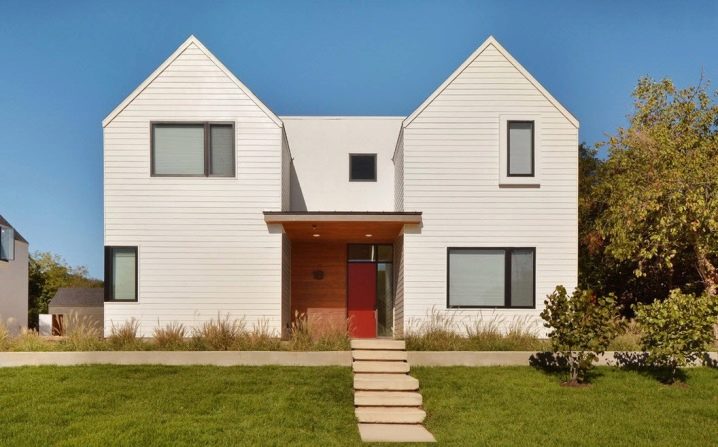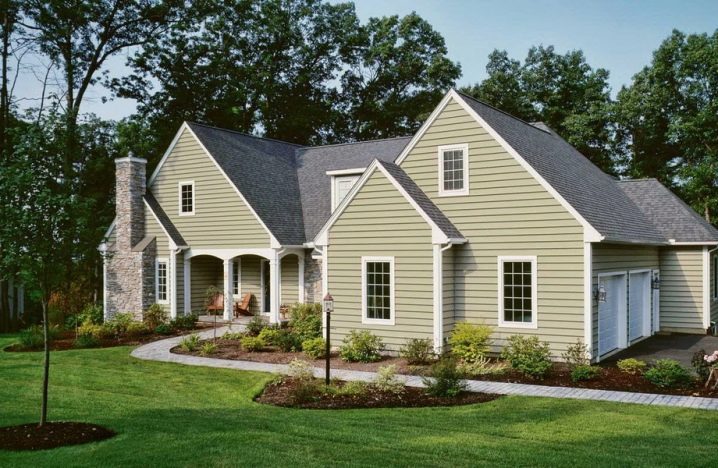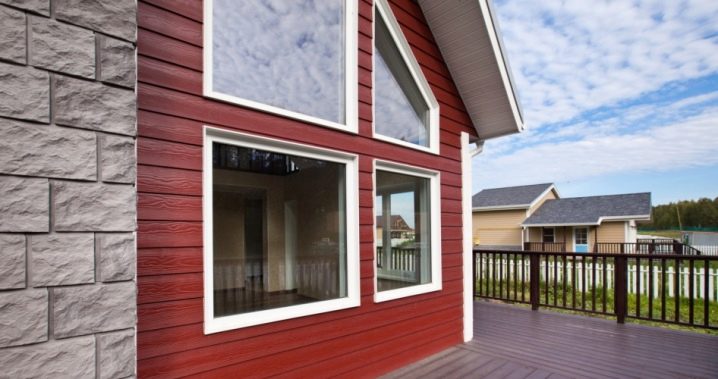Finishing facades of a private house: an overview of modern materials and innovative technologies
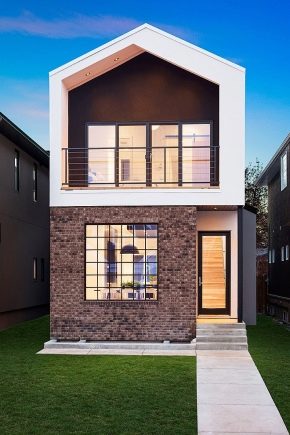
As people are met by clothes, so the house is met by the facade. The decoration of the facade of a private house forms the first idea of the sense of taste and wealth of the owners. However, this does not mean that it should be expensive and fanciful.
Finishing can be done from different materials at the price and appearance, it is only important to choose a suitable one for a particular case. A review of modern materials and innovative production technologies proves that beauty and quality can be affordable.
Features and device
The external lining of the building, whether it is a small country house or an impressive cottage, requires a reasonable approach to the choice of building materials. Facade decoration may be needed in several cases.
- Decorative design of the building. When a building is constructed from practical, but unsightly-looking materials, they are being tried to be disguised with aesthetically appealing "tricks". For example, a house and a bath of arbolit blocks (as well as gas-silicate, foam blocks, cinder blocks and ceramic blocks) are cheap in price, but gray-black rough walls can hardly be called beautiful. They are sheathed with siding or clapboard, and the unsightly design immediately becomes neat "like a toy."
This modern trend is firmly entrenched in construction, because in this way the total cost of building materials and cladding turns out to be much lower than when building a house of brick or timber, and less time is spent. Also often mask panel houses, frame baths, all block buildings.
- Protection of the house from the negative impact of the environment. Weather conditions can reduce the life of the building at times.Materials get wet, rot, burn out, freeze through, overheat and this is not a complete list of problems. They are not peculiar to everyone, but to many building materials, especially traditional ones.
Wooden houses will never lose their value and relevance, because it is a beautiful and eco-friendly material. But moisture resistant wood is very expensive, and the budget alternative after a few decades begins to darken, go stained and loses its attractive appearance. It is no longer possible to return its original cleanliness to such a facade, but to decorate it with modern materials that will look beautiful and protect the tree from further damage is easy. And you can do it yourself.
- Warming of the internal space of the building. Not only the tree requires protection. All block and porous structures are considered problematic facades. The fact is that moisture penetrates into the pores, and then it freezes, and the house becomes cold. To prevent this, a block facade requires an airtight decorative finish.
Do not do without finishing, when the house is built of notoriously cold materials. These are any prefabricated, panel, frame buildings (including European half-timbered houses), porous brick, timber and reinforced concrete structures.In the cold season in these buildings through the walls and the floor there is a large heat loss. Indoors it becomes cold, heating costs increase.
To prevent a problem, it is necessary to sheathe the walls of the building with heat insulating materials. From the inside it is not recommended to do this, since they “eat up” the space of the room and are not always made from safe raw materials. But to finish the walls outside can be effectively and without damage to the usable area inside the house.
The decorative decoration of the facade in this case plays the role of camouflage and protection. The cladding methods are different, but the goal is the same - it covers the ugly lining with heat-insulating plates and provides protection against moisture and dust.
This leads to a logical conclusion: the decoration of the facade performs not only a decorative, but also a practical function. In this regard, there are many requirements for materials: a beautiful and fast result, an acceptable cost, ease of installation, durability.
Requirements
In addition to the requirements that the owner of a private house is able to make, based on logic and intuition, there are also technical standards.All of them relate to two areas: compliance with GOST and compliance with SNiP.
- GOST for each type of cladding your own. Their compliance with the production of material is important because the standard defines the minimum acceptable quality of the material. It regulates the composition of the substance, the permissible amount of hazardous resins and chemicals, the strength of the material and methods for its testing, resistance to weather conditions and mechanical stress, storage rules and methods of transportation.
- SNiP, in turn, control the safety of the use of materials. The main selection criterion is fire resistance class. Acceptable materials that support combustion, but do not ignite, but it is best to choose non-combustible options. This applies to the lining, and to the intermediate layers for thermal insulation - mineral wool, polyurethane foam, foam polystyrene finishing and other insulation.
Also, building codes describe the allowable weight load on the building structure so that it remains safe for life and health. It will be different, for example, for single-story brick cottages and two-story frame buildings.It is important to consider the requirements for a particular type of construction.
Proper use of materials - also from the field of building codes. It is not enough to decorate the facade of a cold house with mineral wool and sheathe it with siding from above. It should be borne in mind that when installing insulation, waterproofing, vapor barrier and ventilation layer are also required. If you do not follow these rules, the effect of finishing will be minus.
In a separate category should be made requirements for the design of finishing materials. Unlike GOST and SNiP, they are not officially fixed on paper and are advisory in nature, but also important.
The facade of the house affects the landscape design and the appearance of other buildings on the site, so the materials need to be chosen so that they look harmoniously against the background of surrounding objects. A Scandinavian-style house in the middle of a Japanese rock garden is an unfortunate combination, but the decoration from natural materials for a house in the style of a chalet, which is surrounded by a country garden, is a winning one. It focuses on the naturalness and simplicity.
Advantages and disadvantages
The facade decoration as a type of repair and construction works has its advantages.
- Some modern materials are designed for inexperienced users. On the packaging of paint products there are detailed recommendations on the choice of tools for application, a set of siding panels is complemented by step-by-step assembly instructions, wooden and plastic lamellas have a simple lock system, which is assembled as a designer.
- With the help of finishing materials, any facade gets a neat decorative look. This may be a new block house or a wooden structure of the last century. Facing with new material will give it a modern, neat and beautiful look.
- Under the decorative trim you can hide insulation and insulation materials
- A variety of shapes, colors and textures of finishing materials makes it possible to trim the facade in a certain style.
- Imitation of expensive materials from more practical raw materials saves the budget of home owners.
- Decorative trim can be changed as it wears, and with it the look of the house will change. Thus, it will always be in line with fashion trends.
- Science and production continue to evolve. Naturally improving the quality of materials.If two decades ago, combustible sawdust and wet foam were used for rough wall cladding, today they have been replaced with safety OSB-plates and sprayed polyurethane foam.
Now let's talk about the cons.
- Finishing works always require foundation preparation. If it is planned to paint the walls, they must first be primed and leveled; if the cladding is needed, the installation of the batten is necessary. These activities require additional time, finances, and sometimes skills. Not every home owner is capable of equally well managed with a paintbrush and building level.
- Manufacturers of building materials are often cunning, saying that their material is so simple that an unprepared person can work with it. This leads to the fact that homeowners are superficially acquainted with the technology of installation and make many mistakes. These errors reduce all efforts to nothing: the skin is leaking, does not hold heat, is easily damaged. It is especially difficult to work with hard-to-reach places and protruding parts of the structure: window openings, penthouses, balconies, foundation.
- Many materials are not reusable.If during the installation a gross error was made, the facing fragment will have to be replaced with a new one.
- Not every facing can be repaired. For example, it is easy to fix plaster and paint in those places where it broke away, scratched or stained, and plastic or wooden panels will have to be completely disassembled if one element in the structure is damaged.
- Not all materials belong to the budget. Various slabs of chips, paint, plaster, siding are available on any budget, but stone or precious wood trim is expensive.
Species
Options for finishing the facade of a city or country house are varied. Some materials are suitable for the repair of their own hands, others require professional intervention. In both groups, it is possible to distinguish specialized types, which are intended specifically for the decoration of the facade, and borrowed materials. Often they are combined. So, along with the use of plaster, there can be a cladding of facade elements with a professional sheet, and flat slate can be combined with stone.
A review of popular materials will help to make the right choice.
Painting
About 20-30 years ago, painting the walls of the house was the easiest and fastest way to design and belonged to the category of “cheap and angry”. Modern paint for outdoor work budget only in comparison with more complex materials: tile, brick, wood. By itself, the exterior finish using paint has become more difficult, but the result is more resistant.
Consider the advantages of paint for decorating the facade.
- Suitable for all surface types. It fits equally well on wood, brick, plaster, new and old materials.
- When processing wood and bricks, many types of paints help to display their texture. This is important for loft and eco-design.
- There are many options for applying: rollers, spray gun, paint brushes. You can work without training.
- On the processing of the facade will take just a day.
- Paint - a convenient material for creating a decorative effect. She can draw a picture, select individual elements of the facade, combine colors to visually change the architectural appearance of the house.
- Modern exterior paints protect the facade from rotting, moisture, dust, rust on metal elements.
- Painted facade can be washed.
- Paint does not lose color for a long time. The lifetime is on average 10 years, then the color needs to be updated.
- On top of one layer of paint can be applied from 5 to 10.
The paint has its drawbacks.
- The paint is liquid, therefore it is easily absorbed into porous surfaces and wood. This leads to a large consumption of material.
- For painting you need a prepared surface. The facade needs to be cleaned of old paint, if it is, dusty, degrease, prime in two layers, and sometimes even with plaster. This is a long process, some of its stages require painting skills.
- One can of paint is cheap, but the facade of the house has a large area, and the paint is applied in two layers. As a result, the budget cost is a relative bonus.
- For the facade are usually used paints are not water-based, and their distinguishing feature - a strong smell of chemistry. Not everyone can work with him.
- Some types of paint can not be washed. They get dirty and lose their gloss in 2-3 seasons. When choosing, you need to be careful.
Options for coloring compositions are varied. They can be divided into three groups.
- Water dispersion paints. These are non-toxic, quick-drying compounds that can be diluted with water.Some of them are universal and are diluted with white spirit and other organic solvents.
For water-dispersion paints are inexpensive compositions based on vinyl, acrylic and coatings based on silicone. Compositions on silicone are considered to be the most suitable for facade work. They have all the necessary properties: from good adhesion to the surface of the walls to water resistance. The coating is not afraid of either moisture or fire. It lies on any surface in an even dense layer.
- Mineral paints. This group includes substances that are based on natural minerals: lime, potassium, cement.
Limy dyes are gradually becoming a thing of the past. They lose to other species in coverage stability and their only merit is low price. For the same reason, alkyd paints are outdated. Paints in which the basis is liquid glass (potassium processing product) work well in operation, but it is difficult to work with them. They require careful preparation of the base and skill. Cement paints are easy to use, they look beautiful on the facade, are varied in colors, but begin to peel off faster than others.
- Rubber paints. Latex in their composition provides a dense, even, moisture-resistant coating. They have high adhesion to the surface. Dried paint has a washable surface and retains its color for a long time. This is the most expensive, but the most effective option for the facade.
Plaster
Plastering of the facade walls occupies a leading position among the types of finishes. There is an explanation for this: the coating is cheap, and the result is excellent.
The method has a number of advantages.
- Stucco is not afraid of moisture. In its composition there are substances-plasticizers, which make it durable and water-repellent.
- The pigment is “embedded” in the mixture, so it begins to fade only after a few years and dims gradually. On the surface of the walls there will be no obvious faded and bright spots.
- The coating does not deteriorate when the ambient temperature drops.
- Plaster "breathes".
- The material is malleable at work.
- The mixture is sold in finished form at an affordable price.
- It covers microcracks and irregularities on the walls, is both the base and the decorative layer.
- Plaster mixes have enormous potential for decorating a facade.You can choose a mixture with decorative additives (coloring pigment, glitter, marble chips), the composition for texture or structural finish.
Decorative plaster makes it possible to imitate expensive materials: marble, stone.
Structural plaster is a mixture to create a non-uniform surface. Popular are the reliefs of the bark beetle, which imitates furrows inside the wood, eaten by the bark beetle, and the fur coat. The fur coat is called the granular surface of the plaster, which in appearance is a bit like a wet stuck pile of paint roller.
Textured plaster is designed to create three-dimensional decor, for example, imitation of stucco:
- relief can be created by improvised means: rollers, stencils, using wrinkled polymer film and foil, spatula, brushes;
- a thick layer of plaster (can reach 10 cm) improves heat and sound insulation in the house.
Consider the shortcomings of the material.
- Requires careful preparation of the surface of the walls.
- If improper preparation, dilution of the mixture with water, applying too thick a layer, the absence of a primer composition, the coating may swell, crack or peel off.
- The plaster quickly hardens in the tank, but dries on the surface of the walls for a long time. Finishing in one layer needs to be completed in a few hours, it is difficult without skills. But for complete drying may take from 7 to 30 days.
- The maximum thickness of one layer is 5 cm. If the layer is larger, the coating will crack due to uneven drying. The second layer can be applied only on top of the primer, and the primer - after 4 weeks.
- Working with plaster requires suitable weather conditions: from 5 to 20 degrees, without rain and heat.
Plaster can be of several types: mineral, acrylic and silicate. The first and second types are universal, and the silicate mixture is intended for porous surfaces. On brick and block walls, it creates a dense protective film without interfering with the vapor permeability of materials.
Siding
Siding siding is an alternative to painting and plastering a budget option.
Siding has several advantages over other materials.
- Low weight. Lightweight prefabricated panels are suitable for finishing solid structures of wood, block, brick, reinforced concrete slabs and for houses whose design does not provide for a large load: frame, prefabricated.
- For the installation of two people enough.
- Low price compared to natural materials.
- It is convenient to mount the panels on top of the insulation. It also improves sound insulation performance.
- Improves sound insulation in the house.
- The top layer of the panels is water-repellent, it can be washed with water with the addition of chemicals.
- Wide temperature range: from -50 to + 50 ° С. Suitable for different regions of the country.
- Panels retain their color for decades. The details of the siding are cast from a substance called compound. It contains various components, plasticizers and coloring pigments. Due to this, the dye is “embedded” in the structure of the material and is not washed out of it.
- Rich selection of colors and textures. Relief and color can imitate wood, brick, stone, other materials.
- Easy to dismantle for changing finishes.
- The facade is neat and stylish.
Minuses:
- panels of saturated color are less protected from UV rays, prone to fading;
- siding is subject to temperature expansion;
- low impact resistance, panels can break from a strong impact, and scratches remain on them;
- the material supports combustion (except metal siding);
- it is difficult to finish the relief facade;
- Requires installation of crates.
Types of siding varied. There are about a dozen panels of various materials and alloys.
- Vinyl siding. The most popular and widespread due to its versatility. It has several varieties: classic (horizontal and vertical), basement and ship. The basement is needed to finish the lower part of the building, and the ship is different in that it looks like a ship's board.
- Acrylic. It is distinguished from other types by characteristics improved in all respects. Withstands the most cold and hot climate, does not burn, is additionally protected from ultraviolet radiation, higher warranty period and price.
- Metal. This name combines the types of panels of copper, aluminum sheet steel. Metal siding is less flexible, but more durable. It can be painted, it is protected from corrosion, non-flammable, may have a decorative coating under the tree or stone.
- Woody. Rarely used for decoration. It is less resistant to moisture, it burns, it has the smallest service life, but it is expensive because of its presentable appearance.
- Cement or concrete. For its manufacture, various mixtures based on high-quality cement with the addition of minerals, plasticizers, and dyes serve as raw materials. A protective layer is applied on top.A mixture is used to create an imitation of natural stone.
Products look beautiful and are cheaper than stone. They are not afraid of moisture and sunlight, but the top layer turns out to be fragile, it is easily broken. The weight of cement siding is large. Need crate with the expectation of additional load.
Slabs
Cheap finishing materials include all types of wood chip and fiber boards.
Cement-bonded, oriented strand and structural insulating panels are mainly used for house cladding.
- For DSP used small wood shavings, Portland cement and chemical additives. Such plates are durable, fire-resistant and waterproof, do not rot, well isolate the internal space of the house, "breathe". Full finish is not considered. Their surface needs to be painted or plastered.
- DSP-plates - heavy, from 10 kg. This complicates the installation of the upper part of the facade and gives a large load on the crate.
- OSB-plates are made from large pieces of wood, they are glued together with the help of resins and synthetic waxes. They are cheap, reliable, and look similar to the texture of solid wood boards.With all the properties of DSP differ in lower weight.
- SIP-panel is a kind of "cake" of two OSB-plates with a layer of polystyrene. The material combines the advantages of OSB-plates and polystyrene foam, as insulation and sound insulator. It weighs a little more and costs more. It serves as a good basis for decorative paint or plaster in the future.
Sandwich panels
In terms of performance, these panels are similar to CIP, but differ in that it is a little simpler and quicker to sheathe their facade. Sandwich panels are a three-layer structure: the base, the insulating layer, the front panel. Foamed polystyrene or cotton wool (mineral, fiberglass, basalt) is used as a layer of insulation.
The outer surface is made of different materials. It can be universal in its properties polyester, a layer of PVC or polyurethane foam, drywall, galvanized steel or aluzink. Of the plastic coatings, polyester is best for a changeable Russian climate. Good in operation and drywall. It has all the technical parameters for exterior decoration and transforms the facade of the house.
Advantages of sandwich panels:
- 3 in 1 material: heat insulation, noise insulation and beautiful exterior finish; no additional steps are required for installing steam and water insulation, ventilation is provided inside the panel;
- the panels are lightweight, it is convenient to finish them and the upper and lower parts of the facade, you can work alone;
- beautiful and neat appearance of the facade is provided;
- bio-resistant panels, are not afraid of moisture;
- installation is carried out in all weather conditions;
- wide selection of colors.
Disadvantages:
- monotonous design;
- panels are difficult to cut and fit in hard to reach places;
- need to handle joints;
- steel faceplate rusts;
- the material is flammable;
- during installation can damage the panel.
Suspended structures
Finishing work with the use of ventilated facades have a lot in common with sandwich panels, but the latter is cheaper. Suspended structures necessarily include a frame made of metal profiles. The empty space is filled with insulation, vapor barrier and waterproofing materials. Between the wall and the frame, as well as between the waterproofing and the inner side of the hinged panels, there remains a ventilation gap.It is necessary for the materials to perform their functions; condensation, fungus and frost do not appear on the walls of the facade.
Suspended structures are not a specific name for a finishing material, but a collective characteristic of their group. They can be wooden, metal, vinyl, from natural and artificial stone, rare raw materials (clinker brick, tile, glass, fiber cement). Wood panels are made by pressing wood fiber with special shrinkage. Additional components increase the resistance of the tree to high humidity and environmental influences. The result is a moisture-resistant, durable, eco-friendly, easy-to-assemble coating.
Wooden ventilated facades require treatment with protective agents, are combustible materials, are more expensive than analogues from other raw materials. But the appearance of the finished decoration - the most powerful argument "for". Vinyl facades are similar in their characteristics to vinyl siding. At a relatively low price, you can purchase a variant from a wide range of colors and textures that imitate various materials.It is easy to care for, resistant to changeable weather conditions, and will be pleasing to the eye for more than a dozen years.
Metal panels and imitation of natural materials are also similar in their characteristics to siding panels.
But the glass structures have no analogues. These are panels which are made by the principle of double-glazed windows.
Their advantages:
- original appearance of the facade;
- thermal insulation and sound insulation at a high level, which provides a special device of glass;
- tinting on glass protects against overheating of the wall at home;
- the thickness of glass units allows you to decorate a frame house with glass panels without the use of additional materials, that is, from the inside it will have transparent walls, and from the outside - tinted or mirrored;
- strength;
- absolute moisture resistance;
- do not fade;
- serve about 50 years.
Disadvantages:
- requires professional skills to work with double-glazed windows;
- need additional measures to create a tightness of finish;
- heavy weight design;
- high price;
- the facade will have to be washed regularly.
Block house
Variety of ventilated curtain walls. The panels are made in the form of logs from the front.When the facade is completely finished with panels with semicircular protrusions and the corresponding decor, the house looks like a fresh and clean log cabin of a wooden hut. The alternative to a block house is a raised beam. These are panels with imitation of a covering by a natural board. There is no pronounced relief.
Tree
The last kind of wood trim is solid wood panels. They are not very popular because the weight of single-piece parts is greater than their imitation of chips and plasticizers, as is the price, and their performance characteristics are inferior to more modern materials. Natural wood for facade cladding must be selected according to such characteristics as biostability and water resistance, otherwise the material will quickly lose its appearance and begin to deteriorate. The most practical option is to decorate the facade with larch, teak or oak lamellae. Avoid birch wood. It is furniture and is not suitable for use on the street.
A rock
Decorative stone decoration is more complicated and more expensive than other methods. Installation requires accuracy, patience and finishing skills. Facing plates with a relief or smooth surface on a cut are made of various natural raw materials. The most expensive cost decorative decoration marble or granite.It is also the most difficult in terms of installation and design. There is a risk to choose the unfortunate color of marble or the size of stone fragments, and the facade of the house will turn out to be gloomy and heavy, rather than elegant.
Often used for finishing limestone, rusty rocks, gabbro-syenite, quartzite, dolomite and porphyry. Facades are trimmed with sandstone, slate and travertine. The finishing material is presented in various formats: euro tiles, dies, fur coats, slabs, wild stone. The eurofloor has the same size and smooth front side. Dies differ in size from tiles, they are made of scraps and 2 times smaller in area. The thickness is the same - 20 mm. "Moscow fur coats" are plates with a pronounced relief on the front side. The most expensive format.
Slabs are cut from a solid block, and the wild stone is as close as possible to the natural form. Its edges are slightly rounded, and the thickness is cut to a maximum of 2 cm.
Stone benefits:
- the stone facade speaks of the prestige of the owners of the house, not everyone can afford such high prices;
- environmentally friendly material;
- color palette consists of natural natural shades;
- has all the necessary characteristics for the facade: not afraid of moisture, sun, dust, does not crumble;
- improves heat and sound insulation;
- durable coating for decades.
Disadvantages:
- laborious finishing process;
- large weight and load on the facade;
- high cost per square meter finish.
Brick
This building and veneer material at the same time, made in the form of individual blocks, rather than props, is able to resurrect the appearance of the facade, even in the most neglected case.
The brick has excellent performance characteristics as a finish:
- the facade takes on a fresh, well-groomed appearance;
- improved insulation and noise insulation in the room;
- shock-resistant material, resistant to damage, not afraid of moisture, does not burn;
- long service life.
There are a lot of disadvantages of brick finishing:
- certain weather conditions are required, the laying will turn out poor-quality at sub-zero temperatures;
- need experience with mortar and brick laying technology;
- the decoration of the entire facade is expensive;
- The total weight of the cladding layer is an enormous additional load on the foundation.
Brick varies in size, color and texture. A small red brick with a porous structure, as well as smooth ceramic products of red, beige, brown, and graphite colors are popular.
Clinker tiles
The brick tile - actually a synonym of the word "ceramic", only it differs in the bigger durability. Make clinkers from plastic clay.
In the process of pressing and firing at temperatures above 1000 degrees, it acquires its positive qualities:
- the minimum level of water absorption is not more than 5%;
- wear resistance;
- resistance to frost, moisture, fire;
- uniform tone throughout the clinker thickness, which makes microdamages, scratches and chips on the surface imperceptible;
- a variety of textures and colors, there is a tile processed, glazed, unprocessed, textured, patterned, combined, colors are the most diverse.
Tiles are cheaper than stone, and the result is quite similar. For installation, you need the skills of finishing work.
Brands
The concept of "quality material" by default implies a bona fide manufacturer.There are many companies in the domestic market that have already earned a name and consumer confidence, but also many brands with low-quality goods. Simplify your search will help focus on popular brands that regularly receive positive feedback from professionals and amateurs.
- Facade paints of good quality produced by firms "Belinka", Alpina, Tikkurila, "Senezh", "Yaroslavl colors". They retain their color for a long time and protect the walls of the facade.
- The undisputed leader in the production of plaster - brand Knauf. Exterior plaster, which meets all technical requirements, is produced in the Rotband line. Ceresit products are no less popular. Ceresite is a product of Henkel.
- Wood chip boards can be safely purchased from a domestic manufacturer. Many countries buy raw materials in Russia, and then repeatedly increase the price for exports, imports, brand and customs duties. Similar quality at a low price is present in small industries: "Hillman", "Kalevala", "Tamak", "Svir".
- Quality SIP-panels and materials for heat and waterproofing produces "TechnoNIKOL".
- Composite panels of excellent quality - from the company Alucobond.
- Bricks can also be purchased in excellent quality from many Russian manufacturers: "Tellurium", "Stone", "Gzhel Brick Factory" etc.
- Among the manufacturers of siding positive comments on European firms Vinyl-On, Mitten, Russian branches of firms "Döcke", St. Petersburg company "Nordside".
- It is recommended to purchase clinker tiles from German companies. ABC, FerdhausKlinker, Roben.
- Facing stone leaders: Camelot, Forester, WhiteHills, Terracotta, Brixtone.
All the manufacturers listed above specialize in the production of materials for construction and repair, and additional elements and tools accompanying finishing (solvents, cement, brushes, painting tools, etc.) can also be purchased from them. In some cases this is of fundamental importance. For example, many siding manufacturers shorten or completely invalidate the warranty period if components were used in the assembly from another manufacturer.
Professional Tips
The choice of materials for finishing the facade is influenced by various factors. It is important and the operational condition of the working surface, and the architectural style of the house, and the surrounding space, and the climate in the region.
In order to revet the facade with a suitable material, it must be selected taking into account recommendations from professionals in the field of construction and repair.
- Modern materials in priority. New technologies open up more opportunities for the production of building materials. Why not stop choosing solid wood, which was valued above all decades and replace it with a block house, which is relevant today?
- Preparing the work surface is as important as the finish itself. A bad foundation will ruin the painting and plastering finishing works. Materials will simply peel off or crack as they dry.
- The composition and properties of the material are listed in the accompanying documentation for a reason. They need to be studied. Otherwise, you can finish the walls with glass fiber concrete, and after a season, begin to wonder at the fragility of the material.
- Suspended structures are always mounted on the batten.
- The most expensive finish is not always the best, the cheapest is not always bad. It is necessary to take into account the climatic conditions.
- When working with any kind of facade panels, it is important to remember that materials are prone to thermal expansion. Therefore, it is impossible to drive in and screw the locking elements into the panel itself.First you need to drill a hole.
- When choosing a design, you need to be guided by the idea of what a house should look like after renovation. Youth, business, strict, modern or deliberately aged?
- Consider the color, material and shape of the roof is required. Visually, it is a single whole with the facade.
- The house can not be considered in isolation from the surrounding landscape and objects. It is necessary to strive for a harmonious combination.
- From time to time you need to take care of the finish: remove the dust, update the color, wash, protect with special means.
Beautiful examples
When choosing the design of the facade, you can bet on a bright color, relief texture, accents on individual details or bold combinations of materials.
Juicy and bright palette is available when painting, plastering and veneering vinyl siding. Such a house will look modern and fresh.
Textured finish will be more relaxed and noble. The most realistic imitation of wood, brick and stone, facing with natural stone and tiles is welcomed.
As accents, it is convenient to select window openings and doors, balconies and decorative elements.They can be made in contrasting colors with the walls of the house, with a different shade not only of the window, but also the area around them.
Bold combinations are: plaster and stone, glass and metal, brick and stainless steel, clinkers and French forging, stucco and marble.
Overview of the facade of a private house with your hands is waiting for you in the next video.
